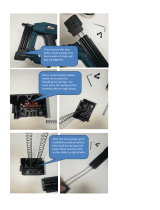
RS 50
4
Release 00 2001-03
REMOVING THE LEFT HANDLEBAR HANDGRIP............................................................................... 7-9
REMOVING THE LEFT HANDLEBAR ELECTRICAL CONTROLS....................................................... 7-9
REMOVING THE CLUTCH CONTROL ...............................................................................................7-10
REMOVING THE THROTTLE CONTROL ........................................................................................... 7-11
REMOVING THE RIGHT HANDLEBAR ELECTRICAL CONTROLS .................................................. 7-12
REMOVING THE STOP SWITCH........................................................................................................7-12
REMOVING THE FRONT BRAKE CONTROL .................................................................................... 7-13
REMOVING THE RIGHT HANDLEBAR .............................................................................................. 7-14
REMOVING THE LEFT HANDLEBAR................................................................................................. 7-14
REMOVING THE IGNITION SWITCH/STEERING LOCK ................................................................... 7-15
REMOVING THE REAR VIEW MIRRORS .......................................................................................... 7-15
REMOVING THE FRONT FAIRING..................................................................................................... 7-16
REMOVING THE WINDSHIELD.......................................................................................................... 7-16
REMOVING THE HEADLIGHT............................................................................................................ 7-17
REMOVING THE DASHBOARD..........................................................................................................7-17
REMOVING THE INSTRUMENT PANEL FRAME ............................................................................... 7-18
REMOVING THE FRONT MUDGUARD .............................................................................................. 7-19
REMOVING THE FRONT DIRECTION INDICATORS ........................................................................ 7-19
REMOVING THE LOWER FAIRING.................................................................................................... 7-20
REMOVING THE REAR FAIRING .......................................................................................................7-21
REMOVING THE REAR LIGHT........................................................................................................... 7-22
REMOVING THE LICENSE PLATE HOLDER..................................................................................... 7-22
REMOVING THE PILLAR COVER ...................................................................................................... 7-23
REMOVING THE REAR TURN SIGNALS ........................................................................................... 7-23
REMOVING THE REAR MUDGUARD ................................................................................................ 7-24
REMOVING THE REAR FOOTREST SUPPORTS ............................................................................. 7-24
REMOVING THE REAR FOOTRESTS ............................................................................................... 7-25
REMOVING THE FRONT FOOTREST SUPPORT (LEFT SIDE)........................................................ 7-25
REMOVING THE FRONT FOOTREST SUPPORT (RIGHT SIDE) ..................................................... 7-26
REMOVING THE FRONT FOOTREST................................................................................................7-27
REMOVING THE SHIFT LEVER ......................................................................................................... 7-27
REMOVING THE BRAKE PEDAL ....................................................................................................... 7-28
REMOVING THE EXHAUST PIPE ...................................................................................................... 7-28
REMOVING THE MUFFLER ............................................................................................................... 7-30
CLEANING THE EXHAUST PIPE AND MUFFLER .............................................................................7-31
REMOVING THE SIDE STAND ........................................................................................................... 7-32
REMOVING THE CHAIN GUIDE......................................................................................................... 7-33
REMOVING THE PILLAR .................................................................................................................... 7-33
FRONT WHEEL ...................................................................................................................................7-36
REMOVING THE COMPLETE FRONT WHEEL.................................................................................. 7-37
DISASSEMBLING THE FRONT WHEEL............................................................................................. 7-38
REASSEMBLY FRONT WHEEL ..........................................................................................................7-40
FRONT BRAKE.................................................................................................................................... 7-42
CHANGING THE FRONT BRAKE PADS............................................................................................. 7-43
REMOVING THE FRONT BRAKE MASTER CYLINDER.................................................................... 7-44
REMOVING THE BRAKE DISC........................................................................................................... 7-44
FRONT FORK......................................................................................................................................7-45
REMOVING THE FRONT FORK .........................................................................................................7-46
DISASSEMBLING THE FORK.............................................................................................................7-47
CHECKING THE COMPONENTS ....................................................................................................... 7-50
REFITTING THE FORK ....................................................................................................................... 7-51
STEERING........................................................................................................................................... 7-54
REMOVING THE STEERING .............................................................................................................. 7-55
CHECKING THE COMPONENTS ....................................................................................................... 7-56
REFITTING THE STEERING...............................................................................................................7-57





















